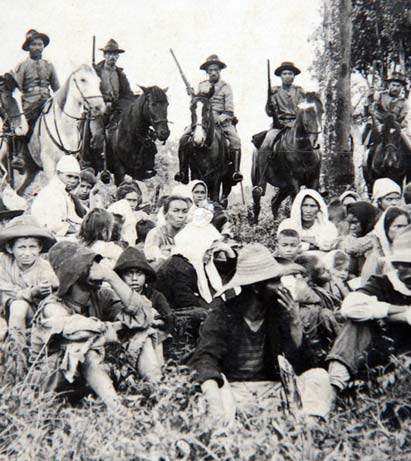
Caboclos circa 1912
Cabanagem

Caboclos circa 1912
The Nineteenth-Century Context of Immigration and Colonization
For half a century after the abolition of the Directorate in 1798, neither
Portugal nor Brazil had an effective settlement policy for the Amazon
Basin. Shortly before Brazil's political independence in 1822, the Belem
elite began a heady orgy of political temper tantrums, pitting Portuguese
against Creole in petty politicking that eventually broke into the open
warfare known as the Cabanagem revolt. The political rhetoric and vitriol
did not reflect fundamental social or economic differences between
the participants but simply questions of political method and the spoils of
office. However, by engaging numbers of the semifree peasants and
detribalized Indians of the region (known as caboclos), workers, and marginal
small farmers to do the physical fighting, the elite foretold their own
destruction. In 1835, when the lower class eventually rose in rebellion
against the men they perceived as authority figures, a good many individuals
of the ruling class died violent deaths.
Most of the fighting and destruction during the Cabanagem took place
in and around Selem, but outbreaks of violence occurred all over the basin.
It was a localized rebellion over local issues, with limited ideological
scope that spread over an immense territory. It was not a revolt with a
clear agenda or purpose, but the violence was often a matter of personal
grudges and vendettas. The caboclos struck out against those individuals
whom they saw as having wealth and power over them, most often being
those of European ancestry. Although not clearly defined enough to be
called race and class warfare, the Cabanagem was definitely a war between
the haves and have-nots. The elite class suffered serious losses, as many died during the shelling of Belem or disappeared after fleeing the
city.
When most of the fighting had ended by 1836, the survivors from the
elite class slowly reestablished their economic control of the basin. In
time, they would again guide the reins of economic growth, but they remained
extremely cautious about their relationship with the caboclos. As
the issue of colonization and settlement of new areas became a major topic
of debate, the residual fear of the violent potential of the caboclos may
well have been one reason for the decision to bring foreign immigrants
rather than resettle and subsidize the native paraenses. The elites had no
intention of allowing the caboclos any opportunity for advancement.
Colonization As Exploitation in the Amazon Rain Forest, 1758-1911 By Robin Leslie Anderson